A remarkable, semi-articulated and near-complete ichthyosaur skeleton from the famous “Jurassic Coast” of Dorset helps to fill an important gap in the fossil record of ichthyosaurs. Named Xiphodracon goldencapensis, this dolphin-sized marine reptile lived in the Early Jurassic. Specifically, it lived during the Pliensbachian stage of the Early Jurassic. The fossil material consisting of a stunning, three-dimensionally preserved skull along with extensive postcranial remains is around 186 to 184 million years old. These fossils could represent the most complete reptile specimen known from the Pliensbachian.
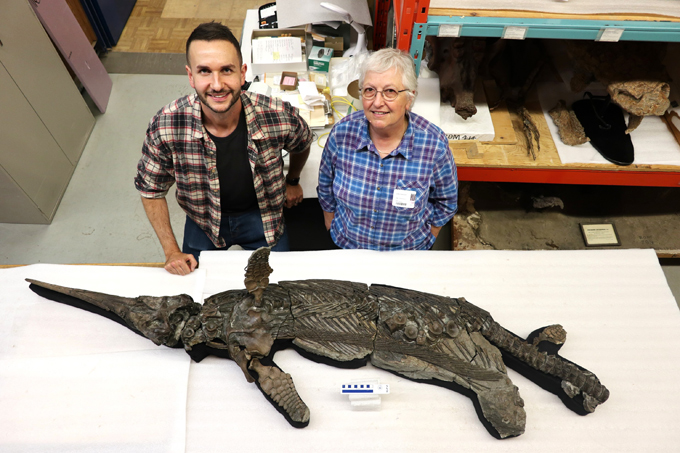
Dr Dean Lomax and Professor Judy Massare study the skeleton of the newly named sword dragon ichthyosaur, Xiphodracon goldencapensis, at the Royal Ontario Museum, Toronto, Canada. Picture credit: Dr Dean Lomax.
Picture credit: Dr Dean Lomax
From Golden Cap
The fossils were discovered in the cliffs near Golden Cap between Bridport and Charmouth on the Dorset coast. The material was found by fossil collector Chris Moore. Chris has found several important marine reptile specimens, including other ichthyosaurs. For example, in 2018 the BBC featured another ichthyosaur fossil discovery from Dorset in the documentary “Attenborough and the Sea Dragon”. Ironically, the ichthyosaur featured in the television programme was probably killed by another ichthyosaur. The newly named Xiphodracon goldencapensis may have suffered a similar grisly end. The top of the skull bears evidence of a bite from a much larger marine reptile.
It has been postulated that the three-metre-long Xiphodracon may have been attacked by a Temnodontosaurus. Temnodontosaurus is a genus of large, predatory ichthyosaurs, some of which could have reached lengths in excess of ten metres.
Ironically, the Temnodontosauridae persisted throughout the earlier Sinemurian stage of the Early Jurassic, through the Pliensbachian and into the Toarcian. However, the composition of the taxa represented by this period of time changed dramatically.
Ichthyosaur expert and co-author of the study, Professor Judy Massare, from the State University of NY at Brockport, (USA) stated:
“Thousands of complete or nearly complete ichthyosaur skeletons are known from strata before and after the Pliensbachian. The two faunas are quite distinct, with no species in common, even though the overall ecology is similar. Clearly, a major change in species diversity occurred sometime in the Pliensbachian. Xiphodracon helps to determine when the change occurred, but we still don’t know why.”
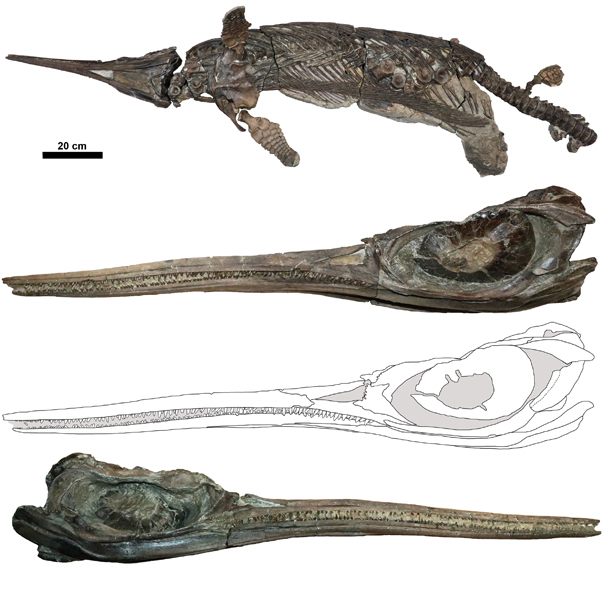
The skeleton and skull of the newly named sword dragon ichthyosaur, Xiphodracon goldencapensis. Picture credit: Dr Dean Lomax.
Picture credit: Dr Dean Lomax
Ichthyosaurs from the Pliensbachian are incredibly rare and this makes Xiphodracon a vital piece of evidence for scientists studying this critical but poorly understood time in ichthyosaurian evolution.
Xiphodracon goldencapensis – “Sword Dragon of Dorset”
The skull has an enormous eye socket. In addition, the rostrum is elongated. Stomach contents may have been preserved, and they indicate that this ichthyosaur dined on fish and possibly squid. The study was undertaken by a trio of international palaeontologists led by ichthyosaur expert Dr Dean Lomax, an Honorary Research Fellow at The University of Manchester and an 1851 Research Fellow at the University of Bristol.
Dr Lomax has also played a crucial role in the development of Everything Dinosaur’s own range of prehistoric animal figures: Everything Dinosaur Evolution.
Dr Lomax commented:
“I remember seeing the skeleton for the first time in 2016. Back then, I knew it was unusual, but I did not expect it to play such a pivotal role in helping to fill a gap in our understanding of a complex faunal turnover during the Pliensbachian. This time is pretty crucial for ichthyosaurs as several families went extinct and new families emerged, yet Xiphodracon is something you might call a ‘missing piece of the ichthyosaur puzzle’. It is more closely related to species in the later Early Jurassic (in the Toarcian), and its discovery helps pinpoint when the faunal turnover occurred, being much earlier than expected.”
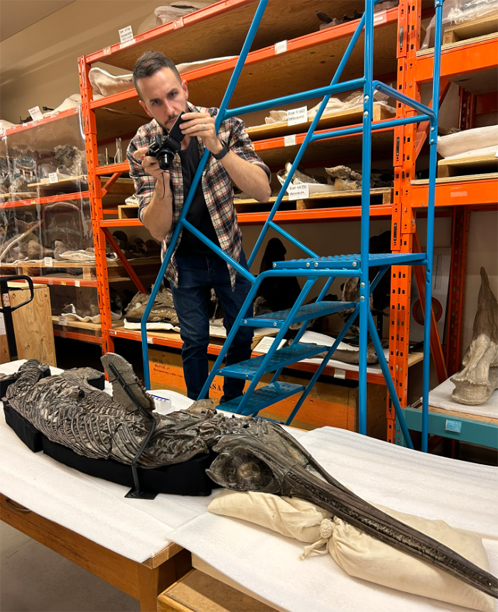
Dr Dean Lomax photographing the skeleton of the newly named sword dragon ichthyosaur, Xiphodracon goldencapensis, at the Royal Ontario Museum, Toronto, Canada. Picture credit: Dr Dean Lomax.
Picture credit: Dr Dean Lomax
Acquired by the Royal Ontario Museum (Toronto, Canada)
After its discovery in 2001, the skeleton was acquired by the Royal Ontario Museum, Canada. It became part of their extensive collection of ichthyosaurs but had remained unstudied.
Co-author, Dr Erin Maxwell, (State Museum of Natural History Stuttgart, Germany) explained:
“This skeleton provides critical information for understanding ichthyosaur evolution, but also contributes to our understanding of what life must have been like in the Jurassic seas of Britain. The limb bones and teeth are malformed in such a way that points to serious injury or disease while the animal was still alive, and the skull appears to have been bitten by a large predator – likely another much larger species of ichthyosaur – giving us a cause of death for this individual. Life in the Mesozoic oceans was a dangerous prospect.”
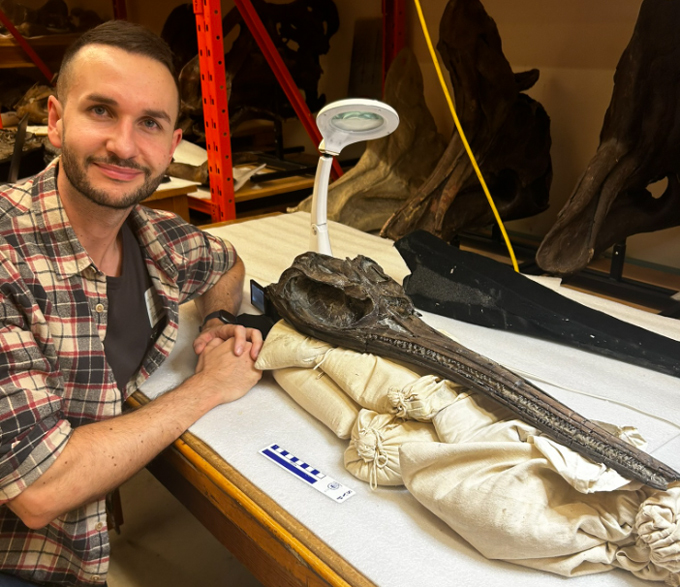
Dr Dean Lomax with the skull of the newly named sword dragon ichthyosaur, Xiphodracon goldencapensis, at the Royal Ontario Museum, Toronto, Canada. Picture credit: Dr Dean Lomax.
Picture credit: Dr Dean Lomax
Collectively, the research team identified several unique features in Xiphodracon that have never been observed in any other ichthyosaur. The most peculiar (autapomorphy) is a strange and unique bone around the nostril (called a lacrimal) that has prong-like bony structures.
Dr Lomax added:
“One of the coolest things about identifying a new species is that you get to name it! We opted for Xiphodracon because of the long, sword-like snout (xipho from Greek xiphos for sword) and dracon (Greek and Latin for dragon) in reference to ichthyosaurs being referred to as ‘sea dragons’ for over two hundred years.”
There are plans to put this remarkable ichthyosaur specimen on display at the Royal Ontario Museum.
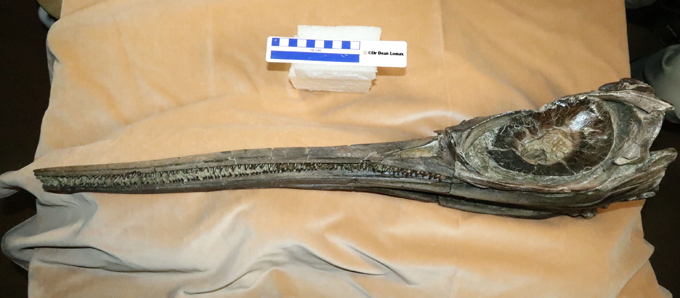
A close-up of the skull of the newly named sword dragon ichthyosaur, Xiphodracon goldencapensis. Picture credit: Dr Dean Lomax.
Picture credit: Dr Dean Lomax
“The Secret Lives of Dinosaurs”
October has been an exceptionally busy month for Dr Lomax. In addition, to the publication of this new study he has recently published a new book. Entitled “The Secret Lives of Dinosaurs” it highlights behaviours of long extinct prehistoric animals through a study of some of the most astonishing fossils ever found.
To learn more about this remarkable book, visit the publisher’s website: Columbia University Press and search for Dr Dean Lomax.
Everything Dinosaur acknowledges the assistance of a media release from the University of Manchester in the compilation of this article.
The scientific paper: “A new long and narrow-snouted ichthyosaur illuminates a complex faunal turnover during an undersampled Early Jurassic (Pliensbachian) interval” by Dean R. Lomax, Judy A. Massare and Erin E. Maxwell published in Papers in Palaeontology.
Visit the award-winning Everything Dinosaur website: Prehistoric Animal Figures.


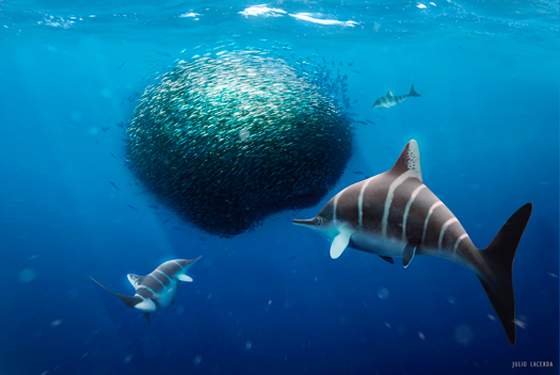
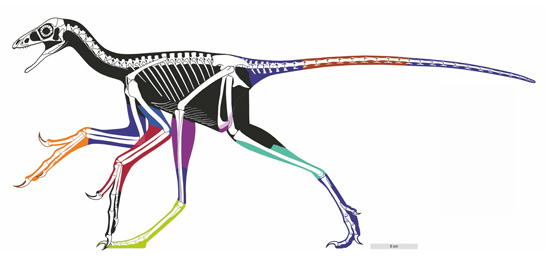
Leave A Comment